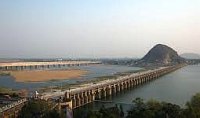Can water interlinking be a good solution for the water deficiency problem in different parts of India?
Civil Services Main Examination
General Studies (Paper - 1) : Model Question & Answers
 Question:
Can water interlinking be a good solution for the water deficiency problem in
different parts of India? Discuss the measures taken by government of India
towards this.
Question:
Can water interlinking be a good solution for the water deficiency problem in
different parts of India? Discuss the measures taken by government of India
towards this.
Interlinking of Rivers asa measure of Water Management
-
The unused water in India is 65 percent which is flowing into the sea and which should be utilized profitably by diverting from surplus areas to deficient areas.
-
Interlinking of rivers was proposed by Sir Arthur Cotton for inland navigation in southern India in the 19th century.
-
The interlinking of rivers (ILR) programme is a major endeavor to create additional storage facilities and transfer water from water-surplus regions to more drought-prone areas through inter-basin transfers.
River Basins: River basins are the basic hydrological unit for assessment of water resources of the country. The entire country has been divided into 20 basins; comprising of 12 major basins having a catchment area of 20,000 km2 and remaining 8 basins are medium and small.
National Commission for Integrated Water Resources Development Plan
Set up in1996 by government of India for preparation of an integrated water plan for development of water resources for drinking, irrigation, industrial, flood control and other uses and to suggest modalities for transfer of surplus water to water deficit basins by interlinking of rivers for achieving the above objectives.
National Water Development Agency
-
The government of India has created the National Water Development Agency in 1982 as an autonomous society to work under the overall control of the Ministry of Water resources.
-
The National Water Development Agency has been carrying out studies of the National Perspective Plan for water resources development. The proposal comprises of two components, namely,
-
Peninsular Component
-
Himalayan Component.
-
The main objectives of NWDA are to study 3 interlinking of river projects to find out the possibilities of the project
-
Himalayan River Development
-
Interlinking of Peninsular Rivers
-
Divert the west flowing rivers in Kerala, Karnataka, Goa, and Maharashtra to East i.e. to Tamil Nadu, Karnataka, Andhra Pradesh, and Maharashtra.
Himalayan River Development
-
For implementing this project cooperation of Nepal, Bangladeshand Bhutan may be necessary.
-
Along with transfer of surplus water, it would also provide the necessary augmentation of flows at Farakka to flush out the Calcutta Port and improve the other inland navigation facilities across the country.
Peninsular Rivers Development
The Peninsular Rivers Development is divided into the following four parts:
-
Interlinking of the Mahanadi-Godavari-Krishna-Pennar-Cauvery.
-
Interlinking of the west flowing rivers north of Mumbai and south of Tapi.
-
Interlinking of the river Ken with Chambal.
-
Diversion of the west flowing rivers of Kerala and Karnataka to the east.
Interlinking of Peninsular Rivers
-
Mahanadi and Godavari link to irrigate the drought prone areas of Maharashtra, Andhra Pradesh and Tamil Nadu.
-
The Krishna – Pennar link toenroute irrigation requirement in Krishna and Pennar basins.
Diversion of West flowing rivers to East
-
In Karnataka, the Western Ghats which is about 13 percent of the geographical area of the state has 60 percent of the state’s water resources in terms of quantity due to high intensity of rainfall.The balance of 87 per cent of the area of the state mostly comprising Krishna and Cauvery basins have only 40 percent of the waters for which Karnataka has water disputes with Tamil Nadu and Andhra Pradesh.
-
Without disturbing the environment and ecology of the forest and without displacement of people, we can easily and economically divert the west flowing water to the east Tamil Nadu across the Ghats through pump storage schemes, utilizing the wasted existing thermal power in the night time.
-
If implemented, it can solve the water and energy problem of Southern states namely Andhra Pradesh, Karnataka, Tamil Nadu, Kerala and Puducherry.
Environmental Hazards
-
Risk of transmigration of species: The local species of fishes were displaced in this case. Such risks of transmigrations in interlinking of rivers are unknown.
-
In the case of India, linking of the Ken and Betwa rivers at the Panna Tiger Reserve in Madhya Pradesh was expected to submerge an important wildlife habitat which was home to many endangered species. Apart from submersion, there were issues of noise pollution and movement of diesel vehicles which would kill the ecology of the forest.
Conclusion:The interlinking can be a solution towards the water scarcity.Along with that, one can irrigate the land by proper management of existing water systems in an efficient manner and by saving rain water. By following ancient water saving mechanisms and storing techniques, can have provide more water storage. So it should be a combined approach including all the good methods, through which India can forget the menace of scarcity forever.
- Reference: YOJANA MAGAZINE (JULY - 2016)
- More GS Mains Model Q&A
- Report Error or Discrepancy
data-matched-content-ui-type="image_card_stacked"
Useful Tips & Articles
तैयारी कैसे करें? |
EXAM SUBJECTS |
STUDY RESOURCESDownload Free eBooks |



